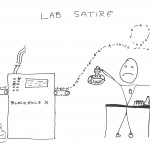We were taught in grade school that DNA is the blueprint of life.
Indeed, the perception in popular culture is that if we read our genetic code, we can foretell our future and understand what defines us as humans. But is reading our blueprint all it takes to understand human biology? We would like to think so as we treat disease, solve crimes, and trace our family tree. And we adhere to this idea as we design our gene knock-out studies. But we are increasingly becoming aware that this ‘blueprint’ transcends a simple code of A, T, C, and G as evidenced by the seemingly endless possibilities for RNA and protein isoforms. Moreover research is continually elucidating how DNA, RNA, and protein interact in a complex self-regulatory network.
While we can experimentally follow some of these molecular pathways that commence with a DNA transcript and result in a physiological outcome, we are discovering that modifications to these molecules can result in a myriad of potentially unexplored biological pathways. Mutations and their phenotypes are relatively simple to conceptualize, but what about methylation patterns, chromatin structure, or the role of noncoding RNA in expression? For example, methylation patterns can impact gene expression and our increased awareness of these events is drastically changing how bench scientists view disease etiology, prevention, and treatment. But the difficulty lies in being able to identify those methylation patterns or any of the modifications and match them to the growing catalogue of factors that regulate gene expression. As researchers, the question is more important than ever: What kind of knock-out animal did we really make? What is the drug target?

Similarly, we are discovering that RNA modifications and different RNA species can have profound effects for cell biology. I think it is the dramatic change in our understanding of RNA function and the discovery of so many RNA transcript types that highlights just how complex cell biology can be. RNA is more than a passive translator. RNA is able to finely tune the biological outcomes laid out by DNA in direct response to ongoing cell processes and external stimuli. RNA-seq allows the researcher the ability to observe RNA as a genetic cipher in translation or to identify non-coding RNAs that actively modulate protein synthesis and activity.
My next few blog posts will explore in-depth some of these modifications. See ya soon!




